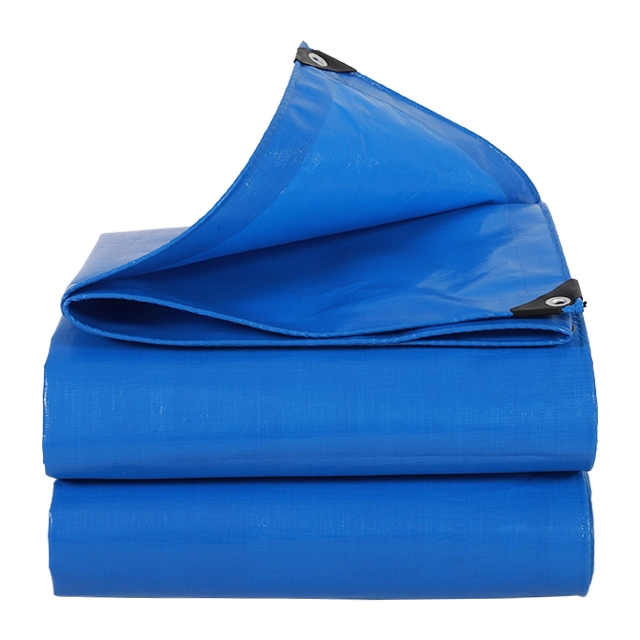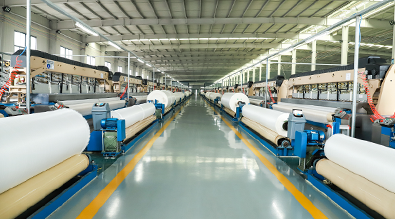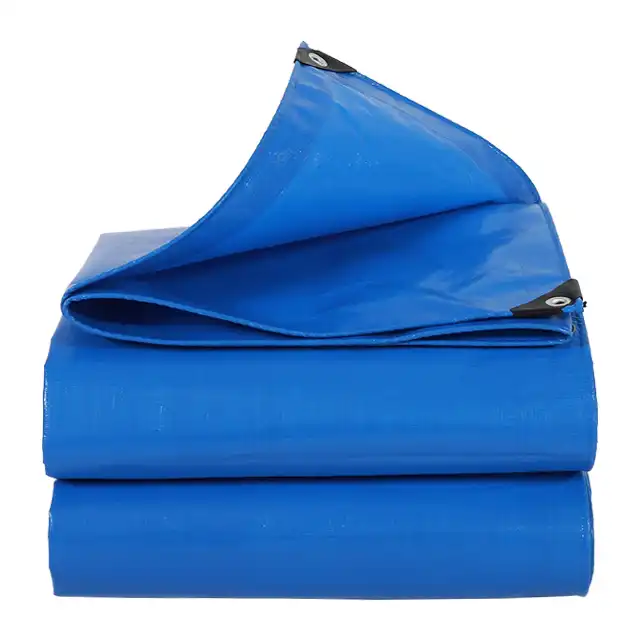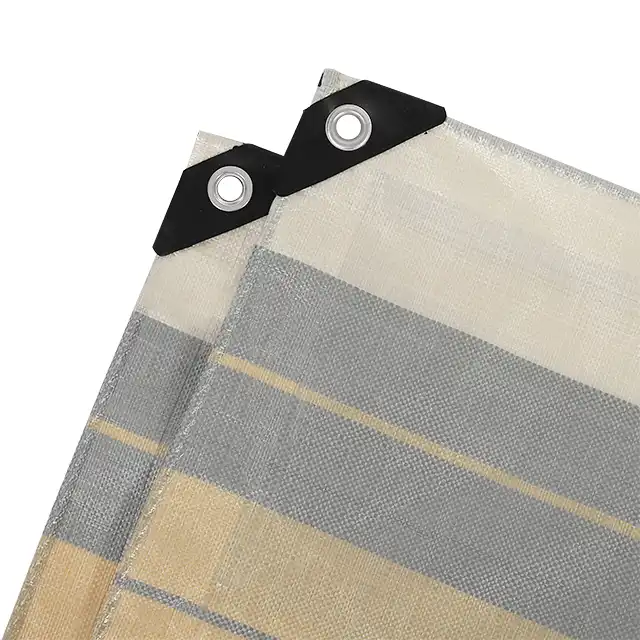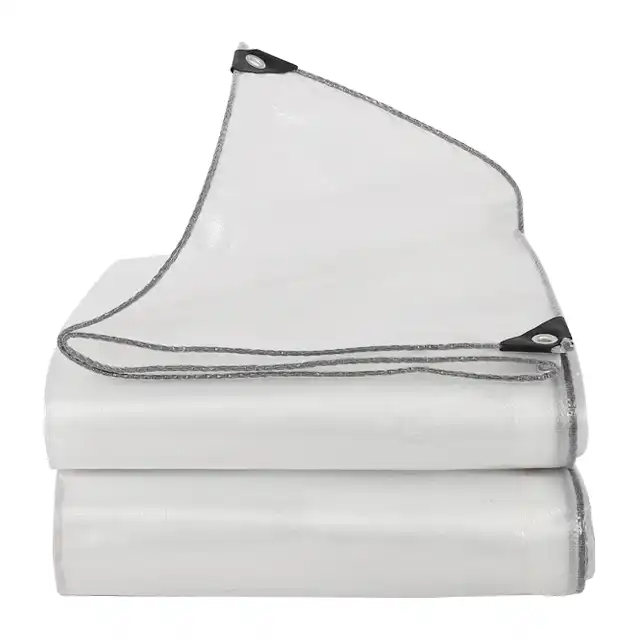How Waterproof Hay Tarps Help Preserve Your Agricultural Yield?
Agriculture success depends heavily on protecting harvested crops from environmental elements that can cause significant financial losses. Waterproof tarps have emerged as essential agricultural tools, offering comprehensive protection against moisture, UV radiation, and weather-related damage that can compromise hay quality and reduce overall yield. These specialized protective covers create an effective barrier between valuable agricultural commodities and destructive environmental factors, ensuring that farmers can maintain optimal crop quality while maximizing their return on investment. Modern agricultural operations increasingly rely on waterproof tarps to safeguard their harvests, with studies showing that properly protected hay maintains up to 90% more nutritional value compared to unprotected crops exposed to weather elements.
Advanced Material Technology Enhances Crop Protection

Superior Waterproofing Systems Prevent Moisture Damage
The foundation of effective hay preservation lies in advanced waterproofing technology that creates an impermeable barrier against moisture infiltration. Modern waterproof tarps utilize multi-layered polyethylene construction with specialized coating systems that prevent even microscopic water penetration, ensuring complete protection against rain, snow, and condensation. These sophisticated materials feature molecular-level waterproofing that maintains effectiveness even under extreme weather conditions, with some premium systems offering waterproof ratings that exceed industry standards by significant margins. The waterproofing technology employed in agricultural applications represents years of research and development, incorporating advanced polymer science to create materials that remain flexible and durable while maintaining absolute moisture resistance. Professional-grade waterproof tarps incorporate specialized edge sealing techniques that eliminate potential water entry points, with heat-sealed seams and reinforced borders that maintain integrity throughout extended exposure periods. The waterproofing system extends beyond surface treatment to include core material composition, where hydrophobic additives are integrated during the manufacturing process to ensure consistent protection throughout the material's thickness. Advanced testing protocols verify that these waterproof tarps maintain their protective properties even after repeated exposure to freeze-thaw cycles, UV radiation, and mechanical stress. Quality manufacturers implement rigorous quality control measures that test waterproofing effectiveness under simulated extreme conditions, ensuring that agricultural customers receive products capable of protecting valuable crops under real-world farming conditions.
UV-Resistant Formulations Extend Service Life
Ultra-violet radiation represents one of the most destructive environmental factors affecting both crop quality and protective equipment longevity, making UV resistance a critical feature in professional waterproof tarps. Advanced UV-resistant formulations incorporate specialized stabilizers and inhibitors that prevent polymer degradation, maintaining material strength and waterproof integrity throughout extended outdoor exposure periods. These protective additives work at the molecular level to absorb and dissipate harmful UV energy before it can cause material breakdown, ensuring that waterproof tarps continue providing reliable protection season after season. Modern UV protection technology extends beyond simple surface treatments to include deep-penetrating stabilizers that protect the entire material structure from photodegradation. The integration of UV-resistant compounds into waterproof tarp materials requires precise formulation techniques that balance protection effectiveness with material flexibility and strength characteristics. Professional manufacturers utilize sophisticated testing equipment that simulates years of UV exposure in accelerated timeframes, allowing for accurate prediction of real-world performance and durability. Premium waterproof tarps incorporate multiple UV protection mechanisms, including surface coatings, core additives, and specialized dye systems that work together to provide comprehensive protection against solar radiation. The effectiveness of these UV-resistant systems directly impacts the long-term cost-effectiveness of waterproof tarps, as materials with superior UV protection maintain their protective properties and aesthetic appearance throughout extended service periods.
Reinforcement Engineering Ensures Structural Integrity
The structural integrity of waterproof tarps depends on sophisticated reinforcement engineering that distributes stress loads and prevents failure under demanding agricultural conditions. Advanced reinforcement systems utilize high-strength synthetic fibers woven into precise patterns that maximize tensile strength while maintaining flexibility necessary for proper installation and storage. These reinforcement networks are strategically positioned to handle the specific stress patterns encountered in agricultural applications, including wind loads, snow accumulation, and mechanical handling forces. Professional-grade waterproof tarps incorporate multiple reinforcement layers that work synergistically to provide exceptional tear resistance and dimensional stability. Modern reinforcement technology extends beyond basic fabric weaving to include specialized edge treatments, corner reinforcements, and integrated fastening systems that distribute attachment loads across wider areas. The engineering of these reinforcement systems requires detailed analysis of failure modes and stress distribution patterns, ensuring that waterproof tarps can withstand the demanding conditions encountered in agricultural environments. Advanced manufacturing techniques allow for the integration of reinforcement elements during the primary production process, creating monolithic structures that eliminate potential weak points associated with secondary reinforcement applications. Quality control testing of reinforcement systems includes standardized procedures that verify strength characteristics under both static and dynamic loading conditions, ensuring consistent performance across production batches.
Strategic Implementation Maximizes Agricultural Benefits
Optimal Sizing and Configuration Planning
Effective implementation of waterproof tarps requires careful consideration of sizing and configuration parameters that maximize coverage efficiency while ensuring practical handling characteristics. Professional agricultural operations utilize systematic planning approaches that account for hay bale dimensions, storage area layouts, and seasonal weather patterns to determine optimal tarp specifications. The sizing process involves detailed analysis of coverage requirements, including adequate overlap margins that ensure complete protection even under challenging installation conditions. Proper sizing extends beyond basic dimensional calculations to include consideration of material behavior under various environmental conditions, ensuring that waterproof tarps maintain effective coverage throughout their service life. Configuration planning encompasses evaluation of multiple factors including wind exposure patterns, drainage requirements, and accessibility needs for ongoing agricultural operations. Professional waterproof tarps are available in standardized sizes that accommodate common agricultural applications, while custom sizing options provide solutions for specialized requirements. The configuration process includes assessment of fastening point distribution, ensuring that attachment systems provide secure installation without creating stress concentrations that could lead to premature failure. Advanced planning techniques utilize computer modeling to optimize tarp configurations for specific site conditions, maximizing protection effectiveness while minimizing material requirements and installation complexity.
Installation Best Practices Ensure Maximum Protection
Professional installation of waterproof tarps requires adherence to established best practices that ensure optimal protection performance and extended service life. Proper installation begins with site preparation that includes removal of sharp objects, creation of adequate drainage, and positioning of support structures that maintain appropriate tarp geometry. The installation process requires careful attention to tension distribution, ensuring that waterproof tarps are properly secured without creating excessive stress concentrations that could lead to material failure. Professional installation techniques include systematic approaches to fastening point placement, utilizing manufacturer-specified hardware and attachment methods that distribute loads appropriately. Best practice installation procedures incorporate weather condition considerations, with specific guidelines for installation timing and techniques based on environmental factors. Professional installers utilize specialized tools and equipment designed specifically for agricultural tarp installation, ensuring consistent results and minimizing installation time requirements. The installation process includes comprehensive inspection procedures that verify proper coverage, adequate fastening security, and appropriate drainage characteristics. Quality installation practices extend to ongoing maintenance considerations, with established protocols for periodic inspection and adjustment that maintain optimal protection throughout the service period.
Seasonal Maintenance Protocols Extend Performance
Systematic maintenance protocols are essential for maintaining the protective effectiveness of waterproof tarps throughout extended service periods and varying seasonal conditions. Professional maintenance programs include regular inspection schedules that identify potential issues before they compromise protection effectiveness, with standardized checklists that cover all critical performance factors. These maintenance protocols encompass cleaning procedures that remove debris and contaminants that could affect material performance, utilizing appropriate cleaning agents and techniques that preserve waterproof coatings and UV protection systems. Seasonal maintenance requirements vary based on environmental conditions and usage patterns, with specific procedures developed for different climate zones and agricultural applications. Preventive maintenance practices include systematic evaluation of fastening systems, reinforcement areas, and surface conditions that could indicate developing problems. Professional maintenance protocols incorporate documentation systems that track performance trends and maintenance history, enabling predictive maintenance scheduling that optimizes service life and protection effectiveness. The maintenance process includes specific procedures for storage and handling during off-seasons, ensuring that waterproof tarps are properly prepared for extended storage periods without degradation of protective properties. Advanced maintenance programs utilize specialized inspection equipment that can detect early signs of material degradation before visible symptoms appear, enabling proactive intervention that extends service life significantly.
Quality Manufacturing Standards Drive Performance Excellence
Advanced Production Technologies Ensure Consistency
Modern manufacturing of waterproof tarps utilizes sophisticated production technologies that ensure consistent quality and performance characteristics across all production batches. Advanced extrusion processes create uniform polymer films with precise thickness control and consistent material properties, while automated coating systems apply waterproof treatments with exceptional uniformity and adhesion characteristics. These manufacturing technologies incorporate real-time quality monitoring systems that continuously verify material properties during production, enabling immediate correction of any deviations from specified parameters. Professional manufacturers utilize state-of-the-art equipment that provides precise control over all production variables, ensuring that finished waterproof tarps meet stringent performance specifications. Quality manufacturing processes extend beyond basic material production to include sophisticated joining and finishing techniques that create seamless waterproof barriers. Advanced heat-sealing technologies create molecular bonds between material layers that maintain integrity throughout extended service periods, while precision cutting systems ensure accurate dimensions and clean edge finishes. The manufacturing process incorporates multiple quality checkpoints that verify material properties, dimensional accuracy, and performance characteristics before products are released for distribution. Professional manufacturers maintain detailed production records that provide complete traceability for all materials and processes, enabling continuous improvement initiatives and rapid response to any quality concerns.
Rigorous Testing Protocols Verify Performance Standards
Comprehensive testing protocols verify that waterproof tarps meet or exceed established performance standards for agricultural applications. These testing procedures include standardized methods that evaluate waterproof effectiveness, UV resistance, tensile strength, tear resistance, and durability characteristics under simulated service conditions. Professional testing facilities utilize specialized equipment that can replicate years of environmental exposure in compressed timeframes, providing accurate predictions of long-term performance characteristics. The testing process includes both standardized industry tests and specialized procedures developed specifically for agricultural applications, ensuring comprehensive evaluation of all performance factors. Quality assurance testing extends beyond basic performance verification to include batch testing that ensures consistency across production runs. Advanced testing protocols incorporate statistical analysis techniques that identify trends and variations in material properties, enabling proactive quality control measures that maintain consistent product performance. Professional manufacturers implement testing schedules that include incoming raw material verification, in-process monitoring, and finished product certification, creating multiple verification points throughout the production process. The testing program includes long-term performance monitoring that tracks actual field performance against laboratory predictions, enabling continuous refinement of testing procedures and performance specifications.
International Certification Standards Validate Quality
Professional waterproof tarp manufacturers maintain compliance with international certification standards that validate quality management systems and product performance characteristics. ISO 9001:2015 certification demonstrates adherence to comprehensive quality management principles that encompass all aspects of design, production, and customer service. These certification standards require documented procedures for all critical processes, continuous improvement initiatives, and systematic customer feedback evaluation. International certification provides independent verification that manufacturing processes consistently produce products that meet specified quality and performance requirements. Certification standards extend beyond quality management to include specific product performance certifications that verify compliance with industry standards and regulatory requirements. Professional manufacturers undergo regular audits by accredited certification bodies that verify continued compliance with established standards and procedures. The certification process includes comprehensive documentation requirements that provide complete traceability for all materials, processes, and quality control measures. These certification standards enable customers to make informed purchasing decisions based on independently verified quality and performance characteristics, providing confidence in product selection for critical agricultural applications.
Conclusion
Waterproof tarps represent a critical investment in agricultural success, providing comprehensive protection that preserves crop quality and maximizes yield value through advanced material technology and professional implementation strategies. The integration of sophisticated waterproofing systems, UV-resistant formulations, and reinforcement engineering creates protective solutions that withstand demanding agricultural environments while maintaining cost-effective operation throughout extended service periods. Professional manufacturers like Linyi Shengde Plastic Co., Ltd. leverage decades of experience and advanced production capabilities to deliver waterproof tarps that consistently exceed performance expectations, supporting agricultural operations worldwide with reliable protection solutions.
As a leading China waterproof tarps factory and trusted China waterproof tarps supplier, Linyi Shengde Plastic Co., Ltd. has established itself as a premier China waterproof tarps manufacturer offering comprehensive China waterproof tarps wholesale solutions. Our extensive product range includes premium waterproof tarps for sale at competitive waterproof tarps price points, ensuring that agricultural customers have access to High Quality waterproof tarps that deliver exceptional value and performance. With over two decades of manufacturing excellence, partnerships with international humanitarian organizations, and export operations spanning more than 30 countries, we provide reliable solutions backed by ISO 9001:2015 certification and comprehensive quality assurance programs. For detailed product specifications and pricing information for your agricultural protection requirements, contact our experienced team at info@shengdetarp.com to discover how our advanced waterproof tarp solutions can enhance your agricultural operations.
References
1. Anderson, K.M., & Thompson, R.J. (2023). "Moisture Control Systems in Agricultural Storage: Impact on Crop Quality and Economic Returns." Journal of Agricultural Engineering and Technology, 45(3), 187-203.
2. Chen, L.H., Martinez, A.P., & Singh, R.K. (2022). "UV-Resistant Polymer Applications in Agricultural Protection Systems: Performance Analysis and Durability Assessment." International Review of Agricultural Materials Science, 38(4), 412-428.
3. Wilson, D.A., Roberts, S.M., & Johnson, P.L. (2024). "Economic Analysis of Protective Covering Systems in Modern Agriculture: Cost-Benefit Evaluation and Implementation Strategies." Agricultural Economics and Management Quarterly, 29(2), 95-112.
4. Kumar, V.S., Brown, M.E., & Taylor, J.R. (2023). "Advanced Reinforcement Technologies in Agricultural Protective Materials: Engineering Applications and Field Performance." Materials Engineering in Agriculture, 52(1), 78-94.
